Let’s talk Sweeteners!
The theme for June is SUGAR. This post will be the last post for June but I’m sure it won’t be the last post about sugar. I use the term sugar but really June has been about why you should STOP eating sugar.
Two of the posts for this month were recipe posts, a Peanut Butter & Chocolate Cake recipe and Low-Carb Dessert Fluff. So, yes, I’d like you to stop eating sugar but that doesn’t mean I need you to stop enjoying the occasional sweet treat.
So, you’re going to stop eating sugar but you’re still going to enjoy dessert now and then. Not as impossible as it may seem once you know what your choices are for sugar-free sweeteners.
Below are what I consider the best options when it comes to sugar-free, zero carb sweeteners. Some I use, others I haven’t tried but plan to. The links in this are amazon affiliate marketing links. If you choose to follow one of my links, I will earn a small commission from Amazon at no additional cost to you. Please don’t feel pressure to buy through my links, they are there for your convenience. If they help point you to a product that you prefer to buy from a favorite retailer that also works : ) If you do click through, thank you, I truly appreciate your support.
Sugar-Free Sweeteners
I’m going to introduce you to a few sugar-free sweeteners. Here’s what you’ll learn:
- What Each Sweetener Is
- Pros / Cons
- How to Measure
The sweeteners I’m going to cover in this blog post are:
- Erythritol (Mannitol, Sorbitol, Xylitol)
- Allulose
- Stevia
- Oligosaccharides / Inulin
- Swerve
- Truvia
- Lakanto “Monkfruit” Sweetener
Sugar-Free Sweeteners vs. Sugar
The whole point of a sugar-free sweetener is to be able to enjoy sweet treats/desserts without the blood sugar and insulin spike that you would get if you used traditional white sugar. I’ve said this before and I’m sure I’ll say it again, there’s no need for sugar OR sugar-free sweeteners in your diet. Your body does NOT NEED sweets. Adding sweeteners to a recipe or making a sugar-free dessert is purely for pleasure. There is no nutritional value to sugar-free sweeteners.
Even though there is no nutritional value, I do think sugar-free treats are a great transition food when making lifestyle changes that include diet change. I also think enjoying a treat or dessert occasionally is super fun and really yummy.
Two things that are important when it comes to sugar-free baking, sweetness and bulk. The bulk is mostly important when baking. Sugar adds bulk to a recipe so if you are converting a recipe and trying to use a sugar-free sweetener you’ll want to match the ingredient bulk/volume that the sugar would have added
Erythritol
Erythritol is a sugar alcohol and is 70% as sweet as sugar. It is naturally found in some fruits like pears, watermelon and grapes and is produced as a by-product when these fruits are fermented. It ranks a big fat zero on the glycemic index meaning, it doesn’t impact blood sugar (or insulin) levels. Erythritol has zero calories and is pretty easy on the digestive tract unlike it’s sugar alcohol cousins, mannitol, sorbitol and xylitol. One more neat thing about erythritol, it doesn’t cause dental decay and may in fact inhibit decay. Sweet! (pun intended).
Erythritol, is different than other sugar alcohols because 90% of it is absorbed in the small intestine. This means that only 10% actually travels through the colon. The 90% that is absorbed in the small intestine is mostly excreted unchanged through the kidneys.
Erythritol is a natural non-sugar sweetener but let’s be clear, it is a processed/refined food. In order to get the yummy bag of sweetness that we all store in our pantry it has to be processed and refined. I’m totally o.k. with that ; )
Pros
- Calorie Free
- Zero Carb
- Glycemic Index of Zero
- It’s easy to use when baking
- It doesn’t cause digestive distress
- It’s tooth friendly
- Doesn’t impact blood sugar or insulin (safe for diabetics)
- It’s a naturally occurring compound
Cons
- Only 70% as sweet as sugar
- Can have a cooling mouth feel when the ratio of erythritol is significantly greater than the other ingredients in a recipe. It creates a kind of mentholated mouth feel.
- The granulated form of erythritol can be persnickety when it comes to dissolving and staying dissolved if too much is used. This will cause your beautiful dessert to have a sandy, crunchy mouth feel – as well as that cooling sensation.
- Erythritol will not caramelize – don’t try to torch it on top of Crème Brulee, won’t work
How to Measure
- 1 TBSP of Sugar = 1 TBSP + 1 tsp of Erythritol
- ¼ cup of Sugar = 1/3 cup of Erythritol
- 1/3 cup of Sugar = 1/3 cup + 2 TBSP of Erythritol
- ½ cup of Sugar = 2/3 cup of Erythritol
- 1 cup of Sugar = 1 cup + 1/3 cup of Erythritol
Note about Carbs
There are those that do consider erythritol to have about .5 net carbs / Tbsp. This would be about 5 net carbs / 100 grams. These are carbs are sugar alcohols. The body doesn’t metabolize this type of carb into glucose and that is why erythritol has a glycemic impact of zero. I consider erythritol to be a zero carb, zero calorie sweetener. Everyone is different, if you find that using erythritol slows your progress perhaps try a different sweetener and always, always remember even treats made with sugar-free sweeteners are to be enjoyed occasionally.
Sugar Alcohols
Quick note about the other common sugar alcohols: mannitol, sorbitol and xylitol, I avoid them. Unlike erythritol, they all go right through your colon and tend to cause digestive upset (gas, bloating, abdominal pain) and often diarrhea. If you’ve eaten too many sugar-free candies you’ll know what I’m talking about.
Mannitol and sorbitol can raise blood sugar levels.
Of the three, xylitol would be the only one I might use. The body does have an enzyme that breaks down xylitol but you still have to start slowly or you’ll end up with digestive upset. Xylitol is also very toxic to dogs and for that reason alone it’s best for me to keep it out of my house.
Final note: be careful with peanut butters. A lot of dog owners give peanut butter to their dogs as a treat. Some peanut butter brands are trying to reduce their sugars and have replaced sugar with xylitol. Read labels so you don’t make the mistake of giving a xylitol sweetened product to your dog.
Allulose
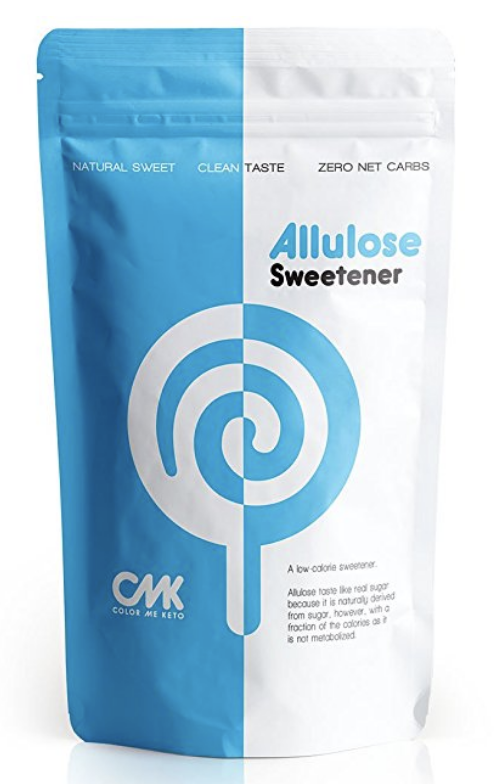 Allulose also known as psicose is considered a calorie-free sweetener that is said to have the same mouth feel as traditional sugar, a clean, sweet taste and texture. I do agree that allulose taste very similar to sugar, more so than other alternative sweeteners.
Allulose also known as psicose is considered a calorie-free sweetener that is said to have the same mouth feel as traditional sugar, a clean, sweet taste and texture. I do agree that allulose taste very similar to sugar, more so than other alternative sweeteners.
Allulose is considered a natural sweetener because it is found in small quantities in foods like wheat, jackfruit, figs and raisins.
Allulose is similar to erythritol in several ways. It is 70% as sweet as table sugar, just like erythritol. Allulose is absorbed similarly to erythritol. The allulose is absorbed but not converted to glucose or metabolized as energy. It doesn’t impact blood sugar or insulin and most of it is excreted through the kidneys. It is easy on the gut and doesn’t tend to cause gastrointestinal issues.
Here is my Amazon affiliate link for Allulose. As always, following my link will not add any additional cost to you.
Pros
- Tastes like sugar
- Will brown like sugar
- Not metabolized as energy by the body (calorie free)
- Measured for baking like Erythritol
- FDA considers Allulose Generally Recognized as Safe (GRAS)
- No after taste
Cons
- Only 70% as sweet as sugar so not 1-to-1 substitution
- Hard to currently find in grocery stores
- Processed – due to extraction from natural products
- May cause GI upset in some
- Could be derived from Corn so some might be GMO based
How to Measure
- 1 TBSP of Sugar = 1 TBSP + 1 tsp of Allulose
- ¼ cup of Sugar = 1/3 cup of Allulose
- 1/3 cup of Sugar = 1/3 cup + 2 TBSP of Allulose
- ½ cup of Sugar = 2/3 cup of Allulose
- 1 cup of Sugar = 1 cup + 1/3 cup of Allulose
Stevia
Stevia is often thought of as a ‘natural’ sugar-free sweetener, which it is, if you grow a stevia plant in your backyard. We do have a stevia plant and we use the leaves to sweeten drinks and food. We pick the leaves off our plant and drop them into our Sun-Tea while it bakes in the sun. The leaves add the perfect touch of sweetness.
If you buy stevia from the store, it’s actually processed and refined. When I buy stevia, I do buy Pure Stevia Leaf Extract. When you read the ingredient list that will be the only thing listed. The only place I’ve found this is at Trader Joe’s. My shopping options are very limited so I’m sure there are other places to buy it. Please read the label.
The sweet stevia species of stevia that is generally made into the sweetener you often see and maybe use is Stevia Rebaudiana. This is known as a zero carb, zero calorie sweetener and that’s how I count it when I use it.
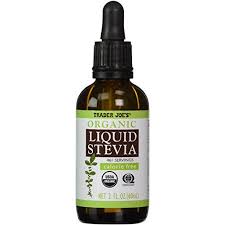 I use two kinds of stevia, an organic powdered version which comes in a little container the size of a salt shaker and an organic liquid version that comes with a dropper top as a dispenser.
I use two kinds of stevia, an organic powdered version which comes in a little container the size of a salt shaker and an organic liquid version that comes with a dropper top as a dispenser.
Note of caution: If you find powdered or granulated stevia and it’s in a bag or container bigger than that little salt shaker size I mentioned it’s probably got fillers. The fillers are typically dextrose or maltodextrin and they WILL have an impact on blood sugar and insulin. If the carbs are less than ½ a gram per serving they tend to be listed as zero. This adds up quickly when you are using larger quantities for baking. If the nutrition label says zero carbs but you see that there is dextrose or maltodextrin in the ingredient list, walk away.
Pros:
- 200x as sweet as table sugar, a little goes a long way
- Does not impact blood sugar or insulin so can be counted as zero carb/zero calorie
- The drops are a simple way to add sweetness to anything especially tea and coffee drinks or perhaps a recipe that needs a little boost of sweetness once all ingredients have been added.
- The powder is great to mix with other sugar-free sweeteners that might need a little boost in sweetness, I’m talking to you erythritol.
- High-quality extracts and tinctures made from whole leaf stevia contain antioxidants
Cons
- If over used, it can have a bitter or licorice taste
- To some, stevia tastes bitter no matter how little is used
- It has no bulk so if substituting stevia for sugar in a recipe this could cause problems
- The highly refined, processed version of stevia has no fiber or nutrients
- Beware or at least careful of stevia blends, many are NOT sugar free, read the ingredient list and scan for dextrose or maltodextrin.
How to Measure
- 1 tsp. of Sugar = 1/16th (or a pinch) of stevia powder or 2-4 drops or 1/8 tsp. of liquid
- 1 TBSP of Sugar = ¼ tsp. of stevia powder or 6-9 drops or ¾ tsp. of liquid
- 1 cup of Sugar = 1 tsp. of stevia powder or 6 tsp. of liquid
Note
This information is for Pure Stevia Leaf Extract. There are many types of stevia available, most are blends because stevia has no bulk for baking. Please read ingredient lists. If you are using a different type of stevia follow the usage instructions on the package.
Inulin | Oligosaccharides | Frutco-Oligosaccharides (FOS)
I included this category because inulin, oligosaccharides and fructo-oligosacchardies are often used in sugar-free sweetener blends.
Inulin is a naturally occurring substance that is often extracted from chicory root but can also be found in other fruits and vegetables such as sunchokes, asparagus, bananas, yacon, and jicama. Inulin by itself isn’t very sweet, only about 10% as sweet as sugar. I’ve never used inulin but I’ve read that it can have a chalky texture and even a slightly tart aftertaste. Inulin is a non-digestible prebiotic fiber that can help promote the growth of beneficial bacteria. As a fiber, inulin has the potential to cause gastrointestinal issues. If you are someone who avoids FODMAPs you should probably stay away from inulin.
Oligosaccharides very much like inulin but easier to mix and dissolve in blends.
Fructo-Oligosaccharides (FOS) are a little sweeter than inulin, about 30-50% as sweet as sugar and are made by breaking down inulin. Two vegetables that have high concentrations of FOS are sunchokes and yacon. Like inulin, FOS is often used to help promote gut health.
Inulin, oligosacchardies and FOS are all great for adding bulk to other sugar-free sweeteners. If you’re a baker you’ll understand the need for bulk or at least equal bulk in recipes when substituting ingredients. If you’re trying to convert a traditional sugar recipe to a sugar-free recipe you’ll want the ingredients to have the same bulk/volume and these sugar-free sweeteners can help.
Pros
- promote gut health due to prebiotic/probiotic nature
- excellent bulking agent for sugar-free sweetener blends
- inulin will caramelize like sugar, bring on the crème brulee!
Cons
- Not necessarily great sweeteners on their own
- Can be hard to find
- Could cause gastrointestinal issues if over used
- May have a laxative effect
How to Measure
I don’t have a sugar conversion chart for inulin or FOS. They are mostly fiber supplements and bulking agents for other sweetener blends. If you really want to include inulin, oligosacchardies and/or fruto-oligosaccharides in your diet I would suggest looking for a sugar-free sweetener that they are included in. This brings me to my next and favorite sweetener : )
Swerve
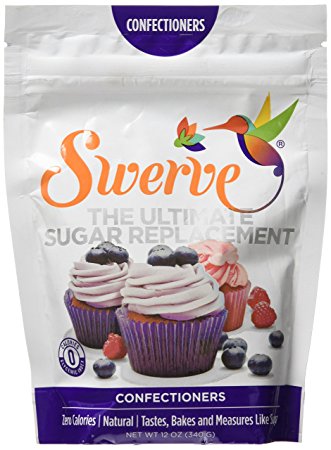 I had to cover oligosaccharides before reviewing my FAVORITE sugar-free sweetener, Swerve. I often think of and refer to Swerve as erythritol. While it is mostly erythritol, Swerve is a blend.
I had to cover oligosaccharides before reviewing my FAVORITE sugar-free sweetener, Swerve. I often think of and refer to Swerve as erythritol. While it is mostly erythritol, Swerve is a blend.
There are three ingredients in Swerve, first is erythritol, second is the prebiotic fiber of oligosaccharides and then some natural flavor from citrus.
There are two types of Swerve, granulated and powdered. The granulated tends to have some of the same issues with re-crystallization when used in large quantities similar to straight erythritol. I tend to use the powdered type of Swerve, the confectioner’s sweetener. I find that this dissolves well and doesn’t typically ever cause a sandy texture in baked goods.
The Swerve website tells you that you can use Swerve cup for cup when substituting for sugar. I don’t find this to be the case. First, that can end up being a LOT of Swerve (erythritol). Second, when you use a lot of Swerve you run the risk of the unpalatable sandy texture or cool mouth feel that I mentioned above about erythritol.
I typically cut the Swerve by 1/3 and then add powdered or liquid stevia until my batter tastes the way I want it. If you’re just starting out, use Swerve the way the package suggests. See what you think, you may love it and not need to make any adjustments. Always try simple first.
Pros
- Zero Carb, Zero Calorie sweetener
- Does not raise blood sugar levels or cause an insulin response
- Doesn’t tend to cause GI discomfort
- Has become easy to find in the baking section of many local grocery stores
- Always available on Amazon
- Works really well when baking, has sweetness and bulk
- As a blend Swerve can be substituted 1 for 1 in place of sugar
- Is certified non-GMO
Cons
- Using too much in a single recipe can cause a cooling mouth feel
- The granulated type can be hard to dissolve and may cause a grainy/sandy texture
- Could possibly cause some gastrointestinal upset in those with very sensitive GI tracts
How to Measure
- 1 Tbsp of Sugar = 1 Tbsp of Swerve
- ¼ cup of Sugar = ¼ cup of Swerve
- 1/3 cup of Sugar = ½ cup of Swerve
- ½ cup of Sugar = ½ cup of Swerve
- 1 cup of Sugar = 1 cup of Swerve
Note about Carbs
As mentioned above, Swerve is a blend of erythritol and oligosaccharides. Remember, some consider erythritol to have about .5 net carbs/Tbsp. I haven’t seen anything specific about oligosaccharides but I have seen it suggested that inulin has about 2.5 – 4 net carbs/Tbsp.
The bulk of this blend is erythritol, a sugar alcohol so those carbs aren’t metabolized like other carbohydrates. I use Swerve as a zero carb, zero calorie sweetener. It’s suggested that 100 grams of Swerve will have the same net carb count as Erythritol, 5 grams.
I’m just throwing this out there incase you find that Swerve slows down your progress. I don’t really think you need to count these carbs but it’s a good reminder to go easy on the sugar-free treats ; )
 Pyure
Pyure
Pyure is also a blend. It is a combo of erythritol and stevia, my two favorite sweeteners. Oddly, I don’t use Pyure. Weird, not sure why I haven’t tried it. As a blend of stevia and erythritol Pyure is a zero carb, zero calorie sweetener. Again, not sure why I haven’t tried this, it’s my two favorite sweeteners already combined. From what I’ve read, the ratio of this blend eliminates the bitterness of the stevia and the cooling mouth feel of the erythritol. Hmmm, sounds pretty good.
Pros
- Combines two zero carb, zero calorie sweeteners: Erythritol & Stevia
- Less bitter than stevia alone
- Zero to no cooling sensation from the erythritol
- Easy to measure, 1/2 cup = 1 cup of sugar
Cons
- It’s the granulated form of erythritol so may be difficult to dissolve
- If you’re sensitive to stevia you may still find that you can taste the stevia
- If you’re sensitive to erythritol you may still notice a cool mouth feel
- There is a sugar blend so make sure and read the label, don’t get the sugar blend
How to Measure
- 1 Tbsp of Sugar = 1 1/2 teaspoons of Pyure
- ¼ cup of Sugar = 2 Tbsp of Pyure
- 1/3 cup of Sugar = 2 Tbsp + 2 tsp of Pyure
- ½ cup of Sugar = 1/4 cup of Pyure
- 1 cup of Sugar = 1/2 cup of Pyure
Pure Monk Fruit Extract
Monk fruit, also known as luo han guo, is a fruit. Unlike other fruits it’s sweetness isn’t due the natural sugars. The sweetness comes from something called mogrosides, powerful antioxidants. These mogrosides aren’t metabolized like sugars which is why Monk Fruit is considered calorie free with no impact on blood sugar or insulin.
As a sugar-free sweetener monk fruit extract is 150 – 250x sweeter than sugar. It doesn’t raise blood sugar levels or insulin so it’s safe for diabetics and it’s considered calorie free.
Pros
- Zero Carb, Zero Calorie
- Super sweet so a little goes a long way
- Great to use in sugar-free sweetener blends
- Contains antioxidants
- Believed to support the health of the immune system, GI tract, and respiratory system
Cons
- Hard to find
- Expensive
- No bulk
How to Measure
- ¼ cup of Sugar = 1/6 of a tsp of Pure Monk
- 1/3 cup of Sugar = ¼ tsp of Pure Monk
- ½ cup of Sugar = 1/3 tsp of Pure Monk
- 1 cup of Sugar = 2/3 tsp of Pure Monk
Lakanto “Monkfruit” Sweetener
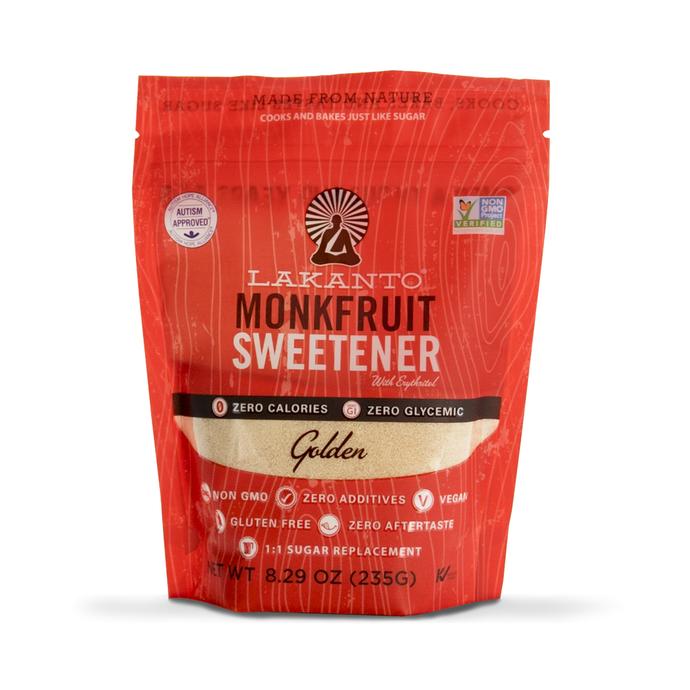 This sweetener is a blend that contains both erythritol and monk fruit extract. It’s interesting that the company refers to this sweetener as a “Monkfruit” sweetener because erythritol is listed as the first ingredient.
This sweetener is a blend that contains both erythritol and monk fruit extract. It’s interesting that the company refers to this sweetener as a “Monkfruit” sweetener because erythritol is listed as the first ingredient.
If you are interested in trying monk fruit this sweetener seems to be the big winner among taste testers. I have to come clean and let you know that I’ve never tried it. However, based on everything I’ve been reading I’m going to order some up and give it a try.
The company offers a variety of products but the two sweeteners are the Lakanto golden and classic. The golden is supposed to have a light, brown sugar taste and can be used in recipes that call for regular sugar. Hmm, interesting, I LOVE brown sugar.
From what I’ve read this particular product isn’t bitter nor does it have an after taste.
The Lakanto website lists these sweeteners as having zero impact on blood sugar.
Pros
- It’s a blend so no need to mix with other sweeteners
- Won’t have an effect on blood sugar or insulin
- Non-GMO
- No bitterness or after taste
- Great for baking
Cons
- Expensive
- Blended with erythritol so if you don’t like erythritol you probably won’t like this
- May be hard to find in a regular grocery store
How to Measure
- 1 Tbsp. of Sugar = 1 Tbsp. of Lakanto Monkfruit Sweetener
- ¼ cup of Sugar = ¼ cup of Lakanto Monkfruit Sweetener
- 1/3 cup of Sugar = 1/3 cup of Lakanto Monkfruit Sweetener
- ½ cup of Sugar = ½ cup of Lakanto Monkfruit Sweetener
- 1 cup of Sugar = 1 cup of Lakanto Monkfruit Sweetener
My Two Cents about Sugar-Free Sweeteners
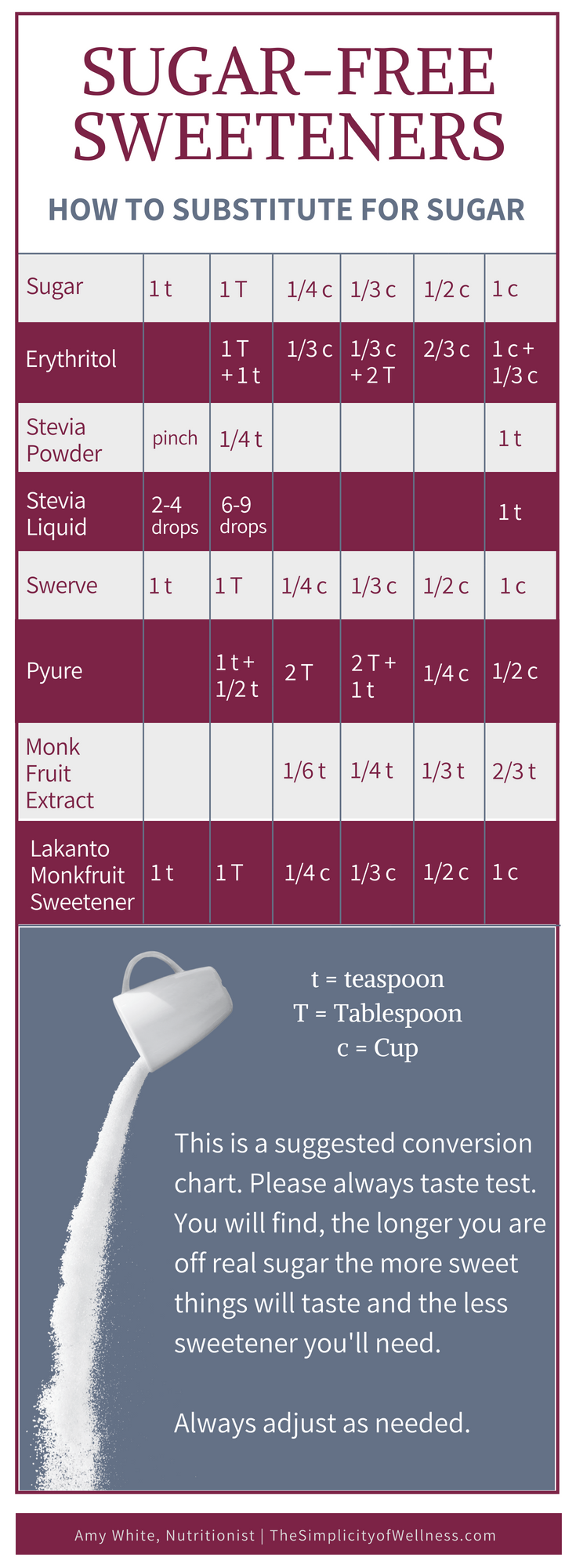 What I LOVE
What I LOVE
I love both Swerve and Stevia. I like to blend the two. I don’t notice any of the weird after tastes with either of these sweeteners. Fine for me but I don’t cook just for me. My family seems to be very sensitive to the mouth cooling effect of the erythritol in Swerve.
Good news, my family has no complaints when it comes to stevia, no noise about a bitter after taste. I find that if I cut the amount of swerve a recipe calls for and replace that with some stevia everyone is happy.
Caution
Weird tastes and a funny mouth feel aren’t the only things you should be watching out for. As I mentioned, I don’t have any taste issues with Swerve or stevia but I still have to be very careful with stevia. Stevia is SWEET and I tend to respond to this sweetness with cravings.
Stevia is not increasing my blood sugar or causing an insulin response, so no blood sugar swings that result in a crash with typical cravings/binging. However, the sweetness of stevia does get my sweet tooth humming and I do start thinking about what other desserts I can have. This tends to get me on a dessert path so my treats become daily instead of occasional. When I start eating treats all the time I don’t feel my best and it starts a slippery slope into other things I wouldn’t normally eat. I know this but those treats are so tasty!
Anyway, notice which sweeteners you like the taste of AND which ones, if any may cause sugar cravings. Go easy on those. I do use stevia for my family but I try to always have a light touch when adding it to recipes that way we can all enjoy and I won’t start having sugar cravings ; )
Try Something New
I do need to branch out and try some other sweeteners. I’m curious to try Pyre and the Lakanto Monkfruit Sweetener, particularly the brown sugar version. I’m wondering if the monk fruit will be enough to offset the erythritol so the mouth feel is more natural (for those who are sensitive). I’m going to give it a try. I’ll let you know what I think. I’m a little nervous that I’ll have the same sweet cravings from monk fruit that I get with stevia but I won’t know unless I try.
Please let me know which non-sugar sweeteners you like and how you use them.
If you’re interested to learn more about how sugar may be impacting your life and health please add your name and email below to receive a downloadable copy of my Sugar Quiz.


I’m Amy a board certified holistic nutritionist, certified functional nutritionist and lifestyle practitioner and certified Life Coach. I help women in midlife understand the changing needs of their body so that they can stop dieting and lose weight permanently. At 56 I live what I teach. Don’t believe the story that your best years are behind you. They are not. Your best years are just starting!

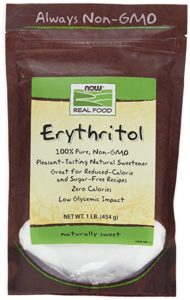
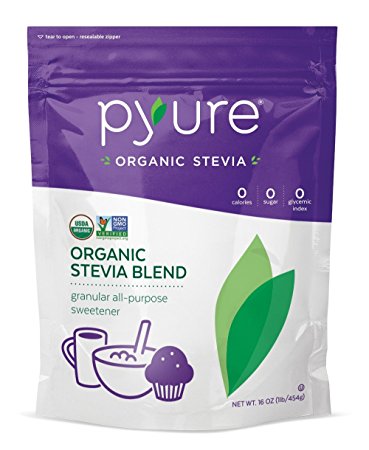 Pyure
Pyure